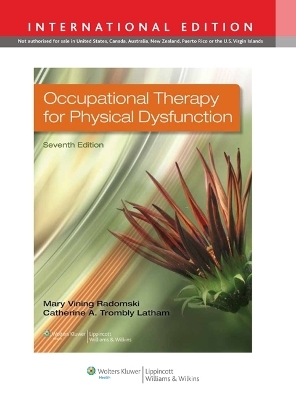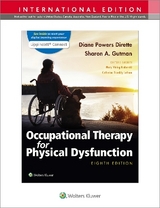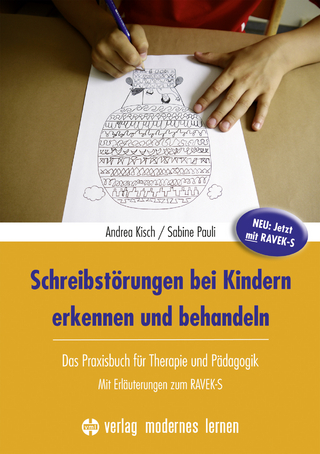
Occupational Therapy for Physical Dysfunction
Lippincott Williams and Wilkins (Verlag)
978-1-4511-8921-6 (ISBN)
- Titel erscheint in neuer Auflage
- Artikel merken
Succeed in the course and master the concepts and skills you need to be an effective, reflective practitioner with Occupational Therapy for Physical Dysfunction, 7th Edition .
The authors introduce the highly acclaimed, easy-to-understand Occupation Functional Model (OFM) in the first section, setting the stage for subsequent discussions that guide you through the assessment and treatment of adult patients with physical dysfunction from initial evaluation to treatment to follow-up.
Featuring engaging and practical coverage, the Seventh Edition includes the latest research in the field, new activity analysis case examples, new photos, new online videos, and a streamlined organization that includes 45 chapters in the print textbook with three additional chapters posted online."
Develop a theoretical foundation to guide your professional decisions through the OFM framework used consistently throughout the book.Access the best evidence for the effectiveness of the interventions discussed in the text with Evidence tables that summarize research studies.
Prepare for professional practice with Assessment tables that highlight the psychometric properties and the strengths and weaknesses of individual assessment methods.
Understand how chapter topics inform occupational therapy practice with Case Example s that describe both the occupational therapy process and the clinical reasoning behind the interventions.
Broaden your understanding of occupational therapy practice with Procedures from Practice, research notes, safety notes, clinical reasoning examples, and review questions.
Maximize your study time with learning objectives, clinical reasoning questions, and a comprehensive glossary.
Extend your learning online with a wide range of resources, including compelling videos that bring key concepts to life, answers to the book’s Clinical Reasoning questions, and Learning Objectives, as well as access to the fully searchable eBook online.
CONTENTS
SECTION I OCCUPATIONAL FUNCTION: DEFINITION AND PROCESS
Chapter 1 Conceptual foundations for practice
Catherine Trombly Latham, ScD, OTR/L, FAOTA
Chapter 2 Practical foundations for practice: Planning, guiding, documenting, and reflecting
Mary Egan, PhD, OT Reg (Ont), FCAOT
Claire-Jehanne Dubouloz-Wilner, PhD, OT (Reg.) FCAOT
SECTION II ASSESSMENT OF OCCUPATIONAL FUNCTION
Chapter 3 Assessing context: personal, social, cultural, situational
Mary Vining Radomski, PhD, OTR/L, FAOTA
Pamela Roberts, PhD, OTR/L, SCFES, FAOTA, CPHQ
Chapter 4 Assessing roles and competence
Susan Fasoli, ScD, OTR/L
Chapter 5 Assessing abilities and capacities: vision and visual processing
Orli Weisser-Pike, OTR/L, CLVT, SCLV
Chapter 6 Assessing abilities and capacities: cognition
Mary Vining Radomski, PhD, OTR/L, FAOTA
M. Tracy Morrison, OTD, OTR/L
Chapter 7 Assessing abilities and capacities: range of motion, strength, and endurance
Lynsay R. Whelan, MS, OTR/L
Chapter 8 Assessing abilities and capacities: motor planning and performance
Khader A. Almhdawi, Ph.D, OT
Virgil Mathiowetz, Ph.D., OTR, FAOTA
Julie Bass, PhD, OTR/L, FAOTA
Chapter 9 Assessing abilities and capacities: sensation
Jennifer L. Theis, MS, OTR/L
Chapter 10 Assessing environment: home, community, workplace access and safety
Patricia Rigby, PhD, OT Reg (ON)
Oana Craciunoiu, M.Sc., OT Reg. (Ont.)
SECTION III THERAPEUTIC MECHANISMS
Chapter 11 Occupation: philosophy and concepts
Catherine Trombly Latham, ScD, OTR/L, FAOTA
Chapter 12 Occupation as therapy: selection, gradation, analysis and adaptation
Catherine Verrier Piersol, MS, OTR/L
Chapter 13 Learning
Nancy Flinn, PhD, OTR/L
Chapter 14 Therapeutic rapport
Linda Tickle-Degnen, Ph.D., OTR, FAOTA
SECTION IV THERAPEUTIC TECHNOLOGIES
Chapter 15 Upper extremity orthoses
Lisa Deshaies, OTR, CHT
Chapter 16 Construction of hand splints
MAJ Charles D. Quick, MS, OTR/L, CHT
MAJ Priscillia Bejarno, OTR/L, CHT
Chapter 17 Wheelchair selection
Brian Dudgeon, PhD, OTR, FAOTA
Jean Dietz, PhD, OTR, FAOTA
Margaret (Meg) Dimpfel, MOT, OTR/L, ATP
Chapter 18 Technology for remediation and compensation of disability
Mary Ellen Buning, PhD, OTR, ATP
Chapter 19 Physical agent modalities and biofeedback
Christine M. Wietlisbach, OTD, OTR/L, CHT, MPA
F. D. Blade Branham, PT, DPT, CHT
SECTION V INTERVENTION FOR OCCUPATIONAL FUNCTION
Chapter 20 Optimizing abilities and capacities: range of motion, strength, and endurance
LTC Andrew Fabrizio, MS, OTR/L, CHT
MAJ Jose R. Rafols, OTD, MHSA, OTR/L
Chapter 21 Optimizing motor planning and performance in clients with neurological disorders
Joyce Shapero Sabari, Ph.D., OTR, FAOTA
Nettie Capasso, M.A.,OTR/L
Rachel Feld-Glazman, M.S., OTR/L
Web A Optimizing motor behavior using the Bobath approach
Catherine A. Trombly Latham, ScD, OTR/L, FAOTA
Kathryn Levit, Ph.D., OTR/L
Web B Optimizing motor behavior using the Brunnstrom approach
Catherine A. Trombly Latham, ScD, OTR/L, FAOTA
Web C Managing deficit of first-level motor control capacities using Rood and Proprioceptive Neuromuscular Facilitation techniques
Catherine A. Trombly Latham, Sc.D., OTR/L, FAOTA
Kathy Longenecker Rust, MS, OT
Chapter 22 Optimizing sensory abilities and capacities
Catherine A. Trombly Latham, Sc.D., OTR/L, FAOTA
Karen Bentzel, MS, OTR/L
Chapter 23 Optimizing vision and visual processing
Jennifer Kaldenberg, OTR/L, MSA, SCLV, FAOTA
Chapter 24 Optimizing cognitive performance
Mary Vining Radomski, PhD, OTR/L, FAOTA
Gordon Muir Giles, PhD, OTR/L, FAOTA
Chapter 25 Restoring the role of independent person
Anne Birge James, PhD, OTR
Chapter 26 Restoring functional and community mobility
Susan L. Pierce, OTR, SCDCM, CDRS
Chapter 27 Restoring competence for homemaker and parent roles
Susan Fasoli, ScD, OTR/L
Chapter 28 Restoring competence for the worker role
Valerie J. Berg Rice, PhD, CPE, OTR/L, FAOTA
Chapter 29 Restoring competence in leisure pursuits
Carolyn Schmidt Hanson, PhD, OTR
Chapter 30 Optimizing personal and social adaptation
Jo M. Solet, MS, EdM, PhD, OTR/L
Chapter 31 Optimizing access to home, community and work environments
Dory Sabata, OTD, OTR
Chapter 32 Preventing occupational dysfunction secondary to aging
Glenn Goodman, PhD, OTR/L
Bette Bonder, Ph.D., OTR/L, FAOTA
SECTION VI REHABILITATION TO PROMOTE OCCUPATIONAL FUNCTION FOR SELECTED CONDITIONS
Chapter 33 Stroke
Anne Woodson, OTR
Chapter 34 Traumatic brain injury
Janet M. Powell, PhD, OTR/L, FAOTA
Chapter 35 Neurodegenerative diseases
Susan Forwell, PhD, OT (C), FCAOT
Lucinda Hugos, MS, PT
Lois Copperman, PhD, OTR/L
Setareh Ghahari, PhD, MSc, BSc (OT)
Chapter 36 Orthopaedic conditions
Colleen Maher, OTD, OTR, CHT
Chapter 37 Hand impairments
Cynthia Cooper MFA, MA, OTR/L, CHT
Chapter 38 Spinal cord injury
Michal S. Atkins, MA, OTR/L
Chapter 39 Rheumatoid arthritis, osteoarthritis, and fibromyalgia
Alison Hammond, PhD, MSc, BSc(Hons), DipCOT
Chapter 40 Burn injuries
Monica Ann Pessina Ph.D, MEd. OTR
Amy Orroth, OTR, CHT
Chapter 41 Amputations and prosthetics
MAJ Sarah Mitsch
Lisa Smurr Walters, MS, OTR/L, CHT
LTC Kathleen Yancosek, PhD, OTR/L, CHT
Chapter 42 Cardiac and pulmonary diseases
Nancy E. Huntley, OTR/L, CES
Chapter 43 Dysphagia
Wendy Avery, MS, OTR
Chapter 44 Human immunodeficiency virus
Karin Opacich, PhD, MHPE, OTR/L, FAOTA
Chapter 45 Cancer
Mary Vining Radomski, Ph.D., OTR/L, FAOTA
Mattie Anheluk, MOT, OTR/L
Kim Grabe, MA, OTR/L
Shayne Hopkins, OTR/L
Joette Zola, OTR/L, STAR-C
| Erscheint lt. Verlag | 13.12.2013 |
|---|---|
| Verlagsort | Philadelphia |
| Sprache | englisch |
| Maße | 276 x 213 mm |
| Gewicht | 3153 g |
| Themenwelt | Medizin / Pharmazie ► Physiotherapie / Ergotherapie ► Ergotherapie |
| ISBN-10 | 1-4511-8921-4 / 1451189214 |
| ISBN-13 | 978-1-4511-8921-6 / 9781451189216 |
| Zustand | Neuware |
| Informationen gemäß Produktsicherheitsverordnung (GPSR) | |
| Haben Sie eine Frage zum Produkt? |
aus dem Bereich



